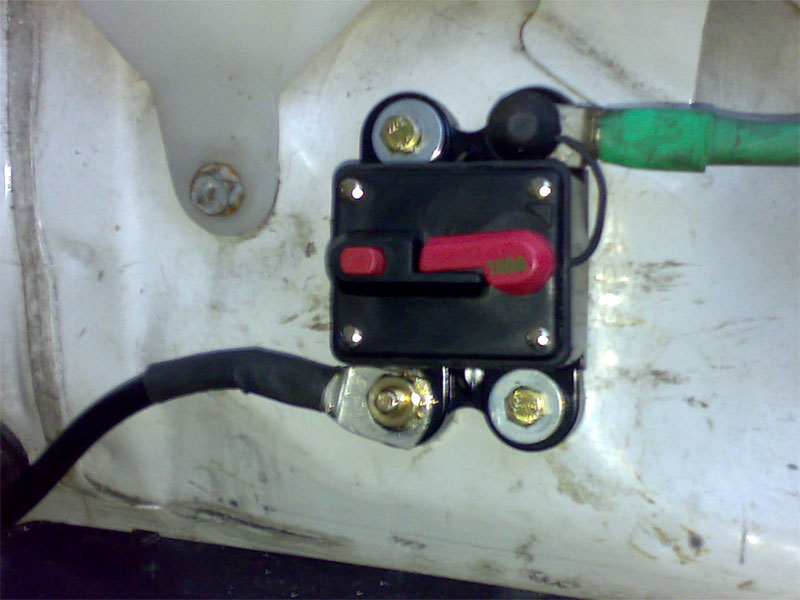I have done this (not quite an intersection though) and yes it would blow, but that's why it would be better to use the contactor to short out the fuse over choosing a fuse rating that wouldn't blow [ever].Originally Posted by cambelt1
(It's also why my battery is half a foot away from my engine).
Depends which welding cable.... Narva has 6 sizes, and if you go by their ratings any of them would be "adequate"Originally Posted by adamaw11
LESS!Originally Posted by adamaw11
Well, not as much current will try to flow because there will be less Voltage to pull the current... and every cable will heat up [a bit].Originally Posted by TERRA Operative
What calculations do you use?Originally Posted by TERRA Operative
Hmm, interesting. The continous current on the 1G-FE was around 140A. Haven't measured the 1UZ or the peak current...Originally Posted by TERRA Operative
Good to see some of the theory worksOriginally Posted by TERRA Operative
At least in theoryOriginally Posted by TERRA Operative
Now more crap, but if you're bored already, skip to the last line
When choosing a cable some things to consider are heat and voltage drop. Can your powered instrument tolerate a voltage drop? Can your cable handle more heat?
Conductor current capacity has various standards of measurement - I don't know what they are specifically, but they are not all same.
For example Jaycar rates an 8 Gauge, 7.5mm^2 cable at 56Amps, however Narva rates a 7.7mm^2 cable at 100Amps at a 60% duty cycle. Narva also rates a 4.6mm^2 cable at 50Amps at 60%dc.
As another comparison, Jaycar 4G 21mm^2 cable is 110Amps, Narva 16mm^2 welding cable is rated at 150 at 60%dc or 215Amps at 30%dc for 5 Minutes (I'm guessing they stop for a smoko after 5 minutes).
The main difference is that Jaycar rates those cables with a continuous load, whereas welding cables don't get used with a continuous duty cycle, giving the cable time to cool down.
Cables with teflon insulation and other high temperature insulators can be rated at higher currents in certain situations as they can take more heat before the insulator stops insulating (ie melting).
A rule of thumb is that every square millimetre of copper can handle around 10Amps continuously. So an 8mm^2 cable should be able to handle around 80Amps continously.
For instance Toyota used a 7.9mm^2 cable on a circuit fused with a 100Amp fuse (which normally would only see about half of that current continously).
And things like jumper leads are another joke - a 200A jumper lead set has less copper than a 25A Jaycar cable. They heat up for a reason
The thinner the cable, the higher the resistance. Extra resistance means LESS current will flow. Less electrical energy will get to the starter.
Everything has resistances, even batteries. The larger the resistance, the larger the voltage drop across that resistance at a specific current - ohm's law - V=IR. The larger the voltage drop, the larger the power dissipation across that resistance - P=VI - the object is to minimise voltage drops - you can't get rid of them completely.
By using a thicker cable you are minimising the effect of the voltage drop of the cable. The longer the cable, the larger the resistance, obviously, so it makes a bigger difference when you install your battery in the boot.
Ever noticed some ground leads from the battery to the chassis are relatively thin compared to the starter cable? The reason is that the cable is very short - maybe 6 inches - so the voltage drop across that cable is relatively low compared to the positive side, so increasing its size has a negligible effect.
In theory the resistivity of materials is more or less fixed and resistances cable be calculated.
Copper is 1.72x10^-8 ohm-metres at 20 degrees C. The resistivity divided by the cross sectional area of the conductor, multiplied by its length, gives the resistance.
So taking our Jaycar 4G cable at 21mm^2, in theory it will have a resistance of 0.000815 ohms per every metre. A ten metre length of this cable will have 0.00815 ohms
In practice, the data tells us the 4G cable has a resistance of 0.00097 ohms per metre.
Practically speaking the 4G cable will give a voltage drop, per metre, rounded, of 0.1V at 100A, 0.2V at 200A, 0.3V at 300A, etc.
Using the Narva 35mm^2 welding cable (rated at 250/355A) these voltage drops would be roughly halved.
Does it make a difference? Sometimes it does, sometimes it doesn't.
A 5 metre length of 4G cable can produce a 1.5V drop at 300A (and 450W of heat!! but only for a very short time) More realistically though, the 0.5V drop at 100A would not make a lot of difference unless your battery is struggling - even a good battery will drop more than 0.5V on cranking.
The voltage drop on an alternator cable doesn't really matter, because the regulator compensates for it anyway - it increases the output voltage to make up the voltage drop at higher currents.
Obviously much smaller currents are involved, but small voltage drops on sensors wiring can have big effect - eg map sensor reading.
On a starter motor, it will only really have an effect with a crap battery or some other problems like loose connections.
Mos.
PS. I'm not bored enough to calculate the temperature rise





 Reply With Quote
Reply With Quote





Bookmarks